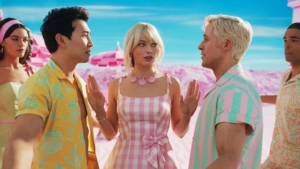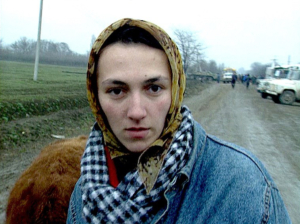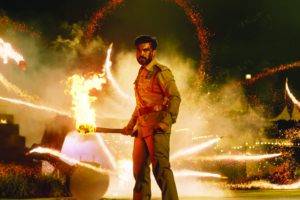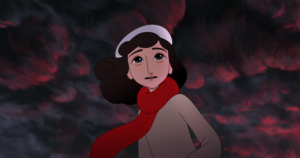In the closing credits of Earwig and the Witch (Gorō Miyakazi, 2020), the twenty-third feature from Studio Ghibli connects with the legendary Japanese animation studio’s past. It features a host of stills, painted in watercolour, that show future adventures: a kind of credit-roll postscript that functions as a what-happened-next epilogue. It’s a direct homage to the credits of the classic My Neighbour Totoro (Hayao Miyazaki, 1988), a reference doubled down on with a drawing of one of Earwig’s demons holding a fuki leaf over its head as an ad hoc umbrella, mirroring one of Totoro’s most famous images. There are further nods to the past – or ‘Easter eggs’, to use the fanservice parlance – when characters are shown watching Howl’s Moving Castle (Hayao Miyazaki, 2004), a bit of meta-Ghibli stream crossing that carries double reference: like that film, Earwig and the Witch is adapted from a book by the late English author Diana Wynne Jones.
These credits feel like a self-conscious attempt to connect with the past, given that Earwig and the Witch is, otherwise, a radical break from it. This is the first ever 3D animated film from Studio Ghibli, a huge change for a company that had, years after Hollywood made the technical switch, persisted with the traditional, time-honoured fashion of 2D hand-drawn animation. For those fans with emotional attachment to the studio, particularly those who had watched Ghibli films in their formative years, there was something reassuring in this ongoing old-timey working way. Upon the debut of the trailer for Earwig and the Witch, there was a huge outcry – beyond the regular low-level outrage-at-everything of the contemporary internet – about its visual presentation.[1]See Gunseli Yalcinkaya, ‘Studio Ghibli Fans Are Horrified by the Earwig and the Witch Trailer’, Dazed Digital, 3 December 2020, <https://www.dazeddigital.com/film-tv/article/51300/1/studio-ghibli-fans-are-horrified-by-the-earwig-and-the-witch-trailer>, accessed 15 February 2021. Here we had a Japanese animation that looked nothing like anime, and one whose embrace of 3D CGI was highly symbolic: a portent of what’s likely to come as the torch of the Ghibli family business is passed down from the iconic father (Hayao, eighty) to the failson (Gorō, fifty-four, maker of the least loved of all Ghibli films, 2006’s Tales from Earthsea). This provoked enough negative reaction that, upon its release, Earwig and the Witch was routinely called ‘controversial’.[2]See, for example, Elizabeth Aubrey, ‘Studio Ghibli Releases Opening Scene from Controversial New Film’, NME, 28 January 2021, <https://www.nme.com/en_au/news/film/studio-ghibli-releases-first-scene-from-controversial-new-film-2867548>; Jacob Stolworthy, ‘Earwig and the Witch: Studio Ghibli Releases First Scene of Controversial New Movie’, The Independent, 28 January 2021, <https://www.independent.co.uk/arts-entertainment/films/news/studio-ghibli-earwig-and-the-witch-release-date-b1793959.html>; and Roisin Lanigan, ‘Watch a Preview for Studio Ghibli’s Controversial New CGI Movie’, i–D, 29 January 2021, <https://i-d.vice.com/en_us/article/wx8b4x/studio-ghibli-earwig-and-the-witch-first-opening-scene-preview>, all accessed 15 February 2021.
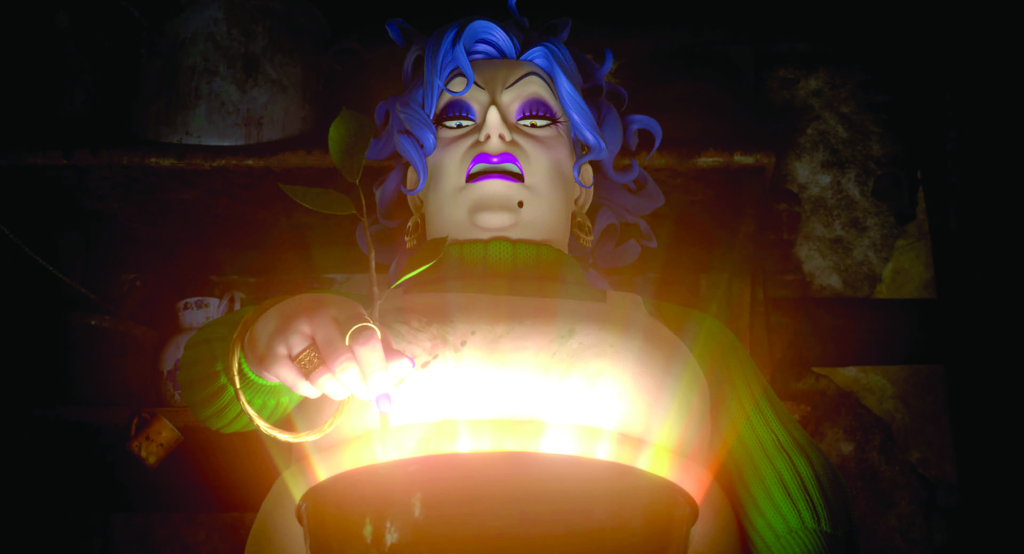
All of which is to say: yes, compared to the glorious history of Studio Ghibli – take, for example, the incredible The Tale of the Princess Kaguya (2013), a lifelong passion project for legendary animator Isao Takahata that artistically foregrounded the wonders of pencil-drawn, handpainted images – the digital imagery of Earwig and the Witch doesn’t look great. Rather than warm, it seems cold; rather than human, it feels mechanical; rather than organic, it looks plastic. Its visual presentation is, in the first reel, hugely confronting and pretty distracting. But there comes a point when the narrative kicks in, when comparisons to the past fade away, and what you’re left with is a cute eighty-two-minute entertainment about a rebellious orphan adopted by a strange couple who turn out to be a demon and a witch. There’s none of the glorious melancholy of peak Ghibli – or, for that matter, the profound existentialism of latter-day Pixar – but, taken on its own merits, the film is a bright, brisk, bratty, impish, rock’n’roll lark, and one with clear themes for its younger viewers.
Agency of children
As an author, Jones stayed almost entirely within the young adult realm, writing texts to be read by children coming into their own. In turn, her novels are, despite their fantasy-world setting, stories about the adolescent realities of upheaval, change, and growing self-determination, in which young characters – usually heroines – find agency and independence in a sometimes terrifying adult world. Earwig and the Witch was Jones’ last finished novel, published posthumously after her death in 2011 at seventy-six. Filled with illustrations and seemingly aimed at younger readers, it is slighter than her many other novels, feeling incomplete, even rushed – something that carries over to the film adaptation, which arrives at its conclusion with an abrupt suddenness. But Earwig and the Witch is another study in the agency of the child, with its eponymous heroine taking control of her fate, manipulating the horrible situations she’s in to her advantage.
Erica Wigg (Kokoro Hirasawa), or Earwig, is a ten-year-old orphan living at St Morwald’s Home for Children in 1990s England. Like the rest of the kids there, she’s subjected to the routine humiliations of the adoption ritual, where children are paraded in front of prospective adoptive parents like cattle; Earwig believes that the parents are like shoppers, seeing the kids as mere dolls. She, in turn, contrives ways of turning off possible parents through a variety of simple schemes. While it’s the standard lot of children in storybook orphanages to long to escape – as her friend Custard (Yusei Saito) does, when gazing at a ship on the horizon while they sit on the St Morwald’s roof – Earwig wants to stay where she is. The orphanage is not just the only home she’s ever known, but she has the run of the place, using her smarts and charisma to get those who run the orphanage to effectively do her bidding.
There’s none of the glorious melancholy of peak Ghibli – or, for that matter, the profound existentialism of latter-day Pixar – but, taken on its own merits, the film is a bright, brisk, bratty, impish rock’n’roll lark.
Things change when Earwig is adopted by a sinister, visually mismatched couple, squat Bella Yaga (Shinobu Terajima) and towering Mandrake (Etsushi Toyokawa). Effectively imprisoned in their home by various spells, our heroine is suddenly yoked to a life of indentured servitude. Not only has she lost the power that she had at the orphanage, but she’s been wholly disempowered, forced to perform demeaning chores (grinding rat bones, slicing snake skins, picking nettles and thistles, mopping goop-covered floors) to aid Bella Yaga’s witchcraft – effectively toiling for her supper, like some volunteer kitchen hand–cum–prison sweatshop labourer. At first, when Bella Yaga says that she’ll teach her new adoptee about witchcraft, Earwig does as she’s asked willingly, but when she discovers she’s never going to move above her slave-labour station, she sets to work.
Rather than finding rescue at the hands of an external force, or via her own special chosen-one status, Earwig must change her fortunes and take her fate back into her own hands through her wiles. With the aid of a talking black cat (not a homage, but nonetheless reminiscent of the sidekick in another Ghibli masterpiece by Miyazaki Sr, 1989’s Kiki’s Delivery Service) named Thomas (Gaku Hamada), she sets about learning some basic spells, repealing the magic of Mandrake that’s holding her hostage.
Mandrake himself is won over by Earwig’s sense of spirit, transforming from a distant figure of terror to someone who begins to display empathy, even warmth, for her. This character arc makes Mandrake feel like a feared father whom the child grows to recognise isn’t mythical, but flawed, and it is in keeping with the tendencies of both Jones and Ghibli to never offer some simple, soon-to-be-defeated villain in whom evil is embodied. With her precocity and pluck, Earwig is a character who refuses to be bowed by fear, never more so than when she is under the same roof as an all-powerful demon and comes to tame the monster. By the time the movie ends, with a six-months-later coda (and, in turn, its credit-roll epilogue), we find that Earwig now has her run of Mandrake’s house, just as she once did the orphanage.
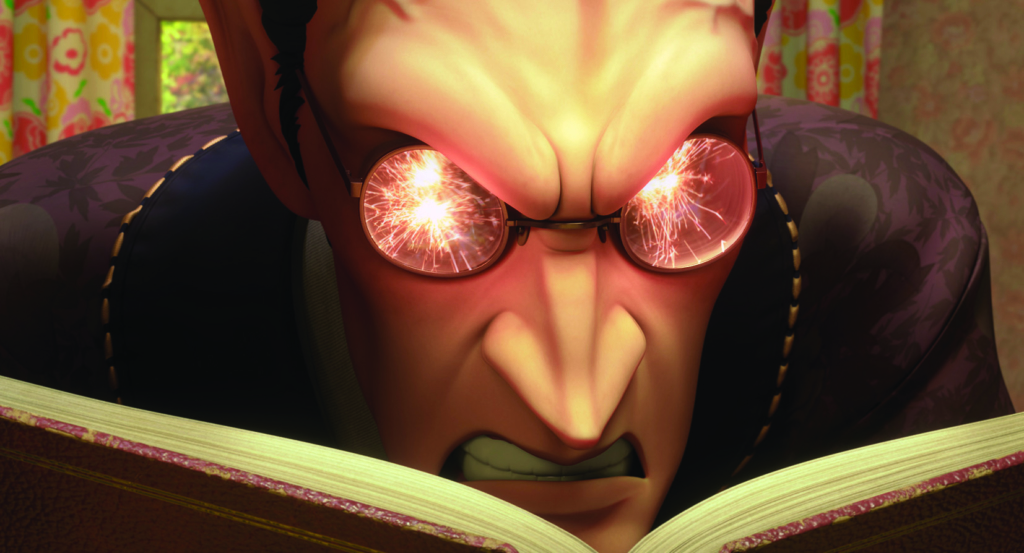
Questioning the world around you
When Gorō Miyazaki was in school, he recounts, he ‘was always questioning why they had all these rules that we needed to follow, [that were] forced upon us without substantial, proper reason’.[3]Gorō Miyazaki, quoted in Matt Patches, ‘Goro Miyazaki on Making Studio Ghibli’s First CG Movie: ‘I Spent a Lot of Nights Not Being Able to Sleep’, Polygon, 28 January 2021, <https://www.polygon.com/animation-cartoons/2021/1/28/22254357/earwig-and-the-witch-studio-ghibli-cg-movie-goro-miyazaki-interview>, accessed 15 February 2021. That familiar edict often handed down to children, ‘You’ll do what you’re told!’ – something Bella Yaga says aloud in so many words – was something that he felt stifled by, rebelled against. And that’s echoed in the story of Earwig and the Witch, where Earwig never accepts that the lot of the child is to suffer; she refuses to allow negative situations (living at an orphanage, being trapped with wicked parents) to remain negative, or to let the ways of the world dictate her emotional state.
This is in keeping with Jones’ ongoing literary predilections. Her books often seem to be encouraging critical thinking in her young readers, with her elaborate fantasy realms rendered as messy, strange and complicated. As her characters figure out these adult worlds – be they as brutal as in The Time of the Ghost or as dystopian as in The Homeward Bounders – they inevitably begin calling them into question (it’s notable that, as a child in wartime England, Jones decided she was an atheist). This models critical thinking for readers, something literalised in Earwig and the Witch by the discovery that the demonic, terrifying Mandrake is actually just a struggling fantasy writer. He’s written a book called Princess and the Witch; when he leaves it for Earwig to read, she deems it boring, its prose tedious and Mandrake – who demands to be left alone to work, locking himself in a magical study to type away – yet another writer too divorced from the world around themselves. This humanises him to Earwig, but also brings him down a few pegs, with her ability to offer him constructive critical feedback becoming an important accelerant in their developing relationship.
Earwig never accepts that the lot of the child is to suffer; she refuses to allow negative situations to remain negative, or to let the ways of the world dictate her emotional state.
Jones spent her career rendering fantasy worlds filled with magic, but so often the magic in her work plays out in mundane fashion and domestic spaces. This is very much the case on screen in Earwig and the Witch, which, upon its protagonist leaving the orphanage, takes place entirely in Mandrake’s magical house. Magic, here, is domestic in both locale and spirit: Bella Yaga makes spells for local customers whose desires are wonderfully quotidian (winning first prize in a dog show, having a lead dancer drop out of a local-theatre recital, making next door’s dahlias wilt). Yet, though it’s often played for low-stakes laughs, magic is still a currency of adulthood and power, things out of reach for Earwig upon her arrival in the house of magic. When Earwig and Thomas, following the spell book like a cookbook, combine forces to enchant their own spells, they are taking that power, and their lives, into their own hands. The thing that has imprisoned them can be used to liberate them, symbolising the way a young person’s increasing agency marks their passage towards adulthood.
The power, and empowerment, of music
When Earwig is dropped at the orphanage – which we see in a car-chase-filled cold-open – she’s left in a basket along with a copy of a cassette. It, like her, bears the name ‘Earwig’, and the tape eventually functions as a tool of liberation, if not divination. Once young Erica has been claimed for adoption by Bella Yaga and Mandrake, and she’s preparing to leave St Morwald’s, she’s given a box of old possessions at the orphanage. Among these dusty relics is the cassette, which she’s never heard of, let alone heard. That only finally happens when Earwig, exploring the varied magical rooms in Mandrake’s house, manages to find first an old ghetto-blaster, then the batteries to power it.
When she puts the tape on – sitting on her bed, at night in her room, the classic setting for youthful musical discovery – it opens her up to a whole new world: not just of expression and rock’n’roll, but also to the secrets of her past, which we view in flashback. On opening, we intuit that the unnamed red-haired woman who drops Earwig off at the orphanage is her mother (Sherina Munaf). She says she’s being chased by ‘the other twelve witches’, which suggests that she, too, is a witch. She also turns out to have been the frontwoman of a band called Earwig, whose members included Bella Yaga (on drums) and Mandrake (on prog-like organ).
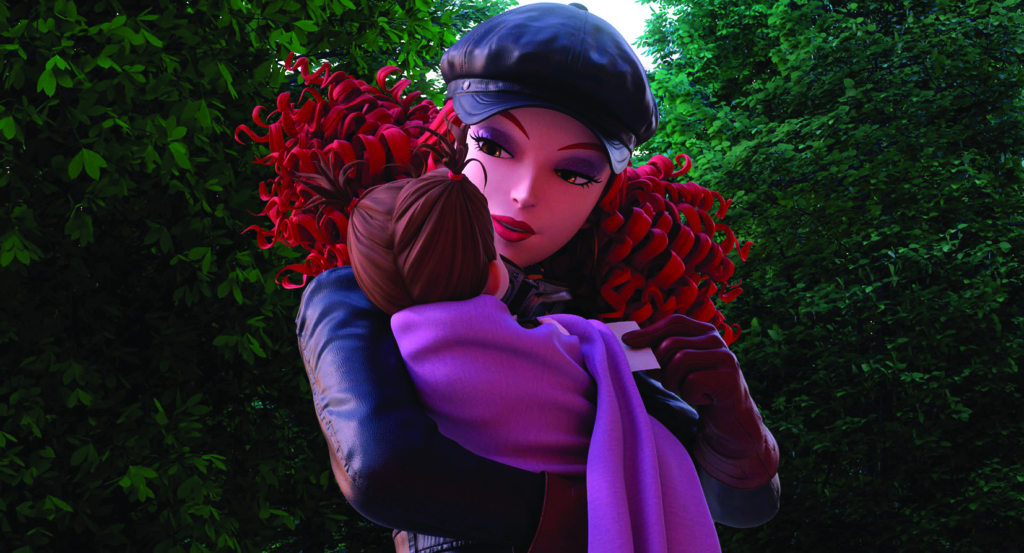
The tape remains a talisman connecting Earwig to her past, though it takes a while for this past to be made clear, and for her birth mother to rise up from it and come back into the present, presaging a happily-ever-after future. The periodic flashbacks throughout the film eventually build to a grand reveal, in which we discover that Earwig the band broke up when their lead singer (she’s listed in the credits only as ‘Earwig’s mother’[4]Voiced in the English dub by Kacey Musgraves, who’s probably sitting there, thinking ’bout the time that’s slipping and missing her mother.) fell pregnant, going on to tell her bandmates that she needed to escape from the clutches of the controlling coven, that she wouldn’t ‘be told what to do by twelve old crones’.
Earwig discovers this when, in the middle of listening to a song, she goes on a psychedelic vision quest to the room next door, leaping through a fiery wall, down a ‘Star Gate sequence’–style tunnel of light into Mandrake’s recording studio. This, the film’s climax, is a visual manifestation of the sense of journeying through sound, entering into fantastical places opened up to you by a song. Earwig has managed to penetrate the spells protecting his space, Mandrake explains, because ‘music lets you into magic places’.
Endnotes
| 1 | See Gunseli Yalcinkaya, ‘Studio Ghibli Fans Are Horrified by the Earwig and the Witch Trailer’, Dazed Digital, 3 December 2020, <https://www.dazeddigital.com/film-tv/article/51300/1/studio-ghibli-fans-are-horrified-by-the-earwig-and-the-witch-trailer>, accessed 15 February 2021. |
|---|---|
| 2 | See, for example, Elizabeth Aubrey, ‘Studio Ghibli Releases Opening Scene from Controversial New Film’, NME, 28 January 2021, <https://www.nme.com/en_au/news/film/studio-ghibli-releases-first-scene-from-controversial-new-film-2867548>; Jacob Stolworthy, ‘Earwig and the Witch: Studio Ghibli Releases First Scene of Controversial New Movie’, The Independent, 28 January 2021, <https://www.independent.co.uk/arts-entertainment/films/news/studio-ghibli-earwig-and-the-witch-release-date-b1793959.html>; and Roisin Lanigan, ‘Watch a Preview for Studio Ghibli’s Controversial New CGI Movie’, i–D, 29 January 2021, <https://i-d.vice.com/en_us/article/wx8b4x/studio-ghibli-earwig-and-the-witch-first-opening-scene-preview>, all accessed 15 February 2021. |
| 3 | Gorō Miyazaki, quoted in Matt Patches, ‘Goro Miyazaki on Making Studio Ghibli’s First CG Movie: ‘I Spent a Lot of Nights Not Being Able to Sleep’, Polygon, 28 January 2021, <https://www.polygon.com/animation-cartoons/2021/1/28/22254357/earwig-and-the-witch-studio-ghibli-cg-movie-goro-miyazaki-interview>, accessed 15 February 2021. |
| 4 | Voiced in the English dub by Kacey Musgraves, who’s probably sitting there, thinking ’bout the time that’s slipping and missing her mother. |

